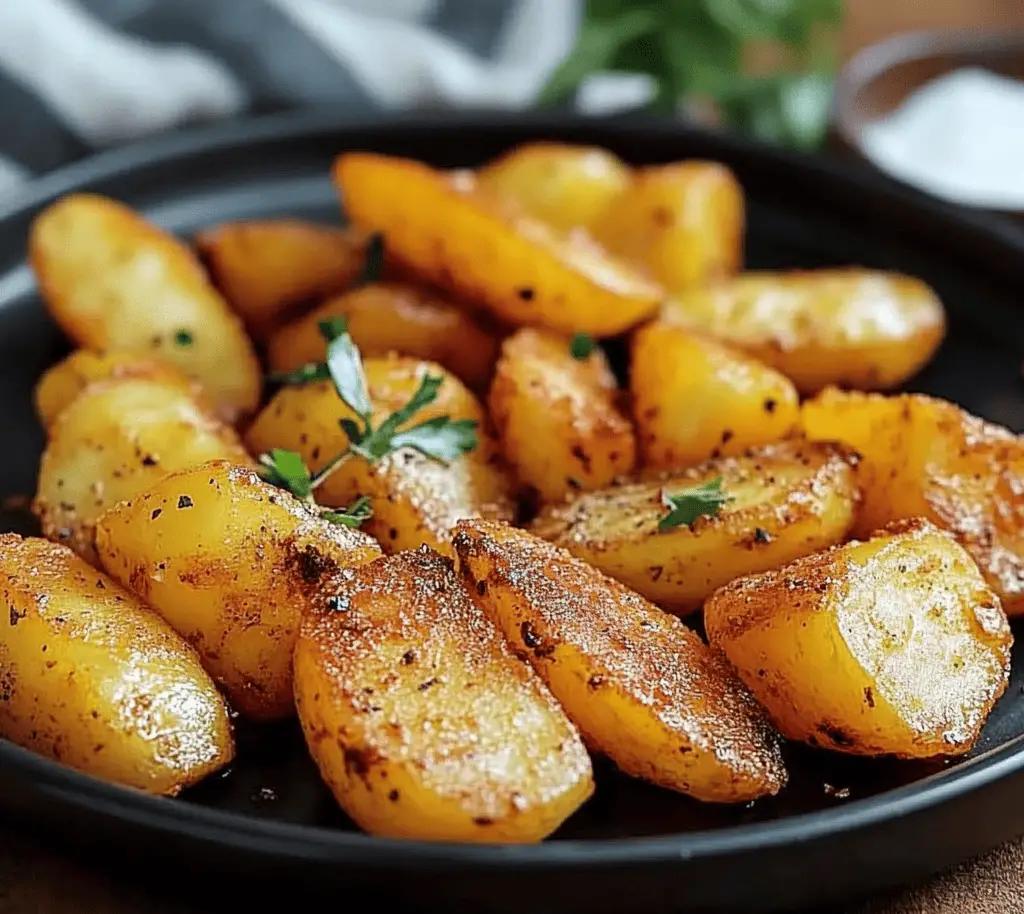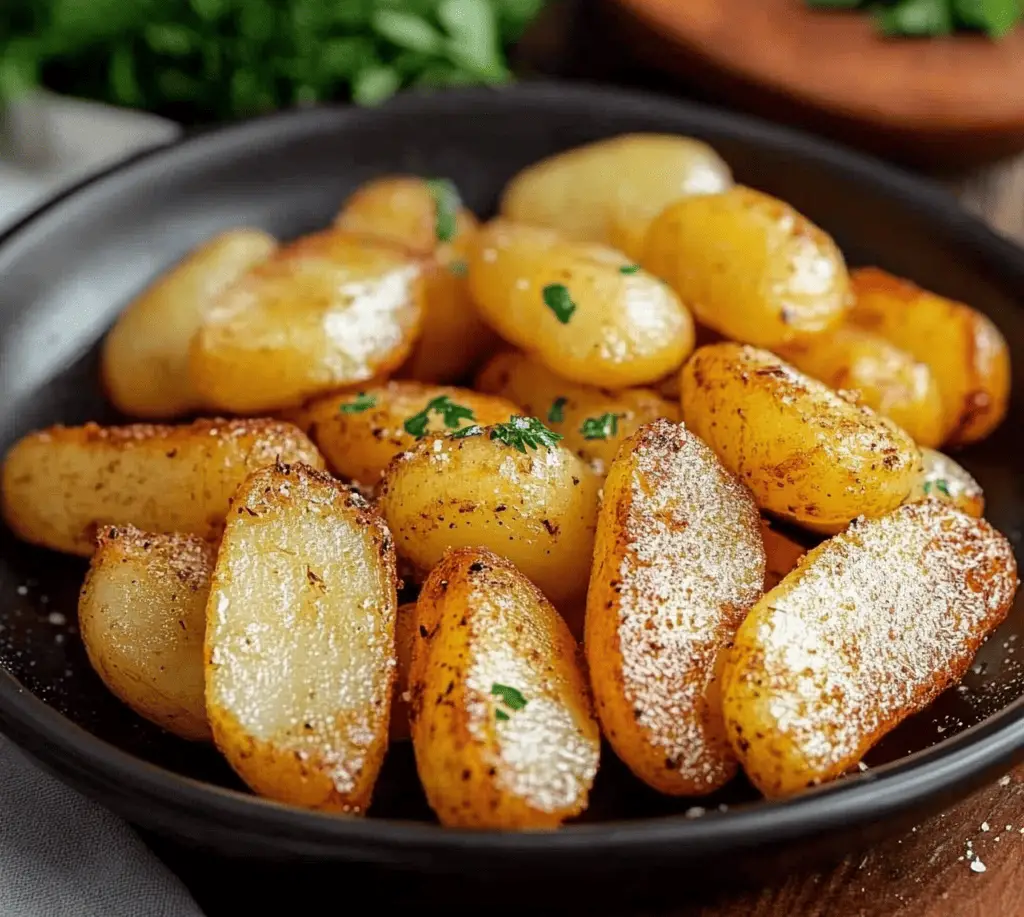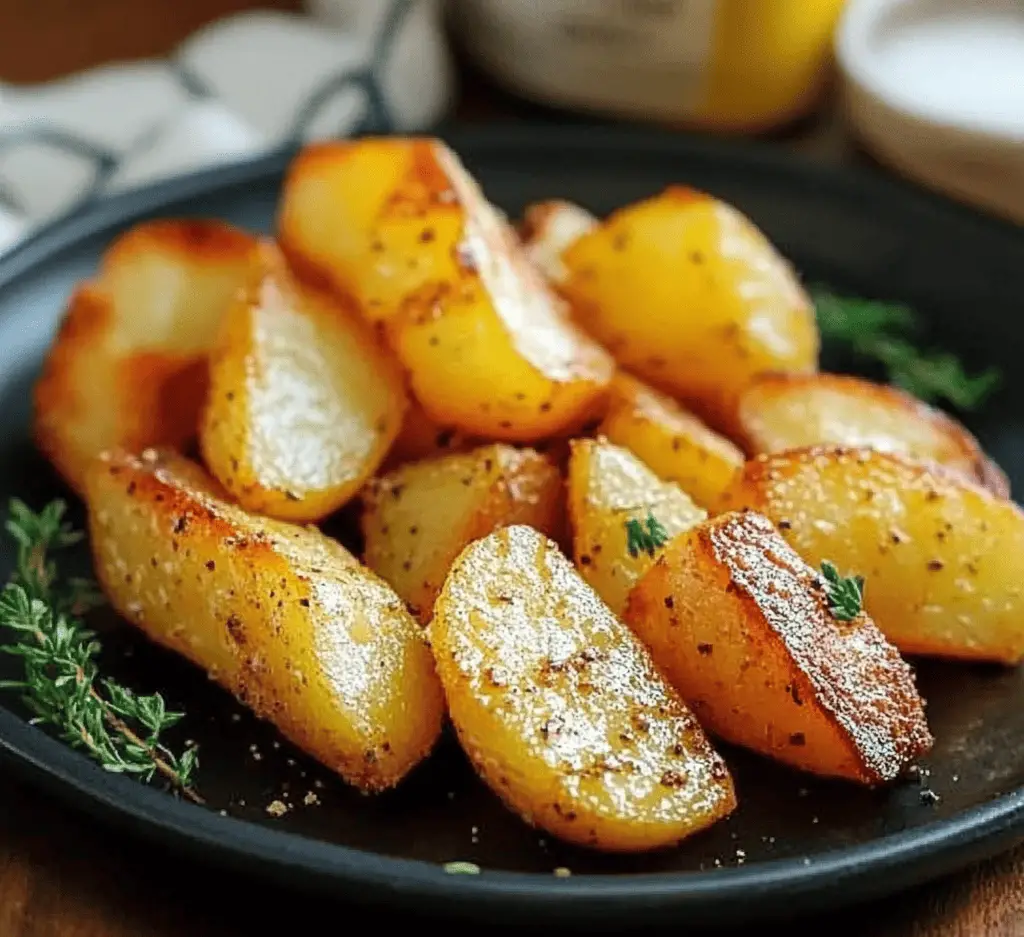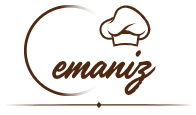Baked Potatoes: The Ultimate Guide to a Perfect Side Dish
Introduction: The Universal Pleasure of a Well-Cooked Potato
In the vast universe of gastronomy, few foods boast the versatility, humility, and comforting power of the potato. From the simple fries that accompany us in our leisure time to the most sophisticated purées of haute cuisine, this tuber has conquered palates in every corner of the planet. The image that calls us today is an eloquent testament to this truth: golden potatoes, carefully cut, with slightly crispy skin and a tender, airy interior, sprinkled with fresh herbs and freshly ground pepper. They are not just potatoes; they are a promise of flavor, an invitation to enjoy home cooking at its finest.
In this detailed exposé, we’ll dive into the fascinating world of roasted potatoes. We won’t limit ourselves to a simple recipe; we’ll travel back in time to unravel their history , from the Andes to the tables of Europe. We’ll break down every ingredient and every step of their preparation so you can replicate and surpass the result in the picture. We’ll explore their texture and flavor , their ideal consumption context , and uncover interesting facts and nutritional benefits that may surprise you. By the end of this read, you’ll not only have the knowledge to prepare the perfect roasted potatoes, but you’ll also have gained a new appreciation for this incredible gift from the earth. Prepare for a culinary journey that will transform the way you view the humble potato.
Detailed History: From Inca Treasure to Pillar of World Cuisine
The history of the potato is an epic tale of intercontinental travel, initial skepticism, and a final acceptance that changed the course of human history and, of course, gastronomy.
Andean Origins: The Gift of the Gods
The birthplace of the potato ( Solanum tuberosum) is found in the high Andes mountains, in the region that today encompasses Peru and Bolivia. More than 8,000 years ago, pre-Incan and Incan civilizations domesticated this tuber, which grew wild. For them, the potato, or “papa” in Quechua, was not just a food; it was a fundamental pillar of their existence, capable of growing at extreme altitudes where other crops like corn could not survive.
They developed thousands of varieties adapted to different microclimates and perfected preservation techniques such as “chuño,” a freeze-dried potato (frozen during the Andean nights and dehydrated by the daytime sun) that could be stored for years, ensuring the empire’s food security. The potato was so vital that it had sacred connotations and was an integral part of their rituals and cosmogony.
The Trip to Europe: A Misgiving Beginning
The history of the potato in Europe begins with the arrival of the Spanish conquistadors in America in the 16th century. It is estimated that the first potatoes crossed the Atlantic around 1570, arriving first in Spain, probably in Seville, one of the main ports for trade with the Indies.
However, its reception was anything but enthusiastic. Europe was a continent deeply skeptical of foods from the “New World.” The potato faced multiple prejudices:
- Botanists: It belonged to the Solanaceae family, the same family as poisonous plants like belladonna and mandrake. This generated a terrible fear that it was toxic.
- Religious: It was not mentioned in the Bible, which for some was reason enough to distrust it.
- Aesthetic and Agricultural: It grew underground, which was considered “dirty” and typical of peasants. Its gnarled, odd appearance didn’t help.
For almost two centuries, the potato was cultivated in Europe primarily as a botanical curiosity in monasteries and aristocratic gardens, or as livestock feed. In Spain, although it was known, its consumption did not immediately become popular, with corn and other established crops being preferred.
Popularization: Hunger as a Catalyst
It was famines, wars, and the efforts of visionary individuals that ultimately cemented the potato’s place in the European diet. In the 18th century, figures such as Antoine-Augustin Parmentier in France carried out veritable marketing campaigns to promote its consumption. Parmentier, who survived as a prisoner of war in Prussia by eating potatoes, became convinced of their nutritional value. He organized banquets for the elite where every dish was made from potatoes and is even said to have placed armed guards around his potato fields during the day to make them appear valuable, removing them at night so the peasants could “steal” them.
In Spain, wars and grain shortages in the late 18th and early 19th centuries forced the population to adopt the potato as a staple food. Its incredible ability to satisfy hunger and its adaptability to the diverse climates of the peninsula quickly became evident. It ceased to be a rarity and became the livelihood of thousands of families.
The Birth of Roasted Potatoes
The act of roasting food is one of humanity’s oldest cooking techniques, mastered since the discovery of fire. Roasting in an oven, however, is a later evolution. With the popularization of wood-fired ovens in home kitchens, both in the countryside and in cities, arose the simplest and most delicious way to cook potatoes: whole or in chunks, seasoned with whatever was on hand, usually oil or animal fat and salt.
Roasted potatoes became a staple dish for several reasons:
- Simplicity: They require minimal preparation.
- Economy: An efficient cooking method, often taking advantage of the residual heat from the oven after making bread.
- Flavor: The dry heat of the oven concentrates the flavors of the potato, caramelizes its natural sugars (Maillard reaction) and creates a delicious dual texture: crispy skin and floury flesh.
The specific cut seen in the image, similar to the “Hasselback,” is a more recent innovation. Hasselback potatoes ( Hasselbackspotatisin Swedish) originated at the Hasselbacken restaurant in Stockholm, Sweden, where they were created in the 1950s. The technique involves flaking the potato almost completely, allowing fat and seasonings to penetrate deeply, creating a crispier surface. The version pictured applies this concept to potato halves, an ingenious adaptation that combines the ease of traditional jacket potatoes with the improved texture of the Hasselback technique.
Today, baked potatoes are a global side dish, a blank canvas for endless flavors, and a dish that evokes home and comfort around the world.

Ingredients
To recreate these delicious roasted potatoes, you’ll need simple but high-quality ingredients:
- Potatoes: 1 kg (choose waxy or all-purpose varieties such as Monalisa, Kennebec, or Red Pontiac, which hold their shape well).
- Extra Virgin Olive Oil: 4-5 tablespoons.
- Coarse or Flaked Salt: To taste.
- Freshly Ground Black Pepper: To taste.
- Fresh Parsley: A small bunch, finely chopped.
- Garlic Powder (Optional): 1 teaspoon.
- Sweet or Spicy Paprika (Optional): 1 teaspoon.
Detailed Preparation
Follow these steps to achieve potatoes with a golden crust and an irresistibly tender interior.
- Preheat the Oven: The first step, and one of the most important, is to preheat your oven to 200°C (400°F) with top and bottom heat. A well-heated oven from the start is key to achieving that crispy skin.
- Wash and Dry the Potatoes: Wash the potatoes thoroughly under cold water, using a vegetable brush if necessary to remove any dirt. Don’t peel them; the skin will become crispy and delicious, while also containing fiber and nutrients. Drying is CRUCIAL. Use a clean dish towel or paper towel to dry them completely. Moisture is the enemy of crispness.
- Cutting the Potatoes: Cut the potatoes in half lengthwise. Now, to achieve the effect shown in the photo, make thin crosswise cuts on each half, without cutting through the bottom. The goal is to create an accordion-like shape. A good trick is to place two chopsticks or the handles of two wooden spoons on either side of the potato. This way, the knife will stop before cutting completely through the potato.
- Dress Generously: Place the potato halves on a large baking sheet, preferably made of dark metal for better heat conduction. Drizzle generously with extra virgin olive oil, making sure the oil penetrates between the slits you’ve made. Use your hands to massage each potato, coating them completely.
- Season: Sprinkle generously with coarse salt and freshly ground black pepper. If you choose to use garlic powder or paprika, this is the time to add them. Salt not only adds flavor but also helps draw moisture out of the skin, contributing to a crispier finish.
- Bake to Perfection:
- Place the tray in the preheated oven.
- Bake for approximately 40-50 minutes. The exact time will depend on the size and variety of your potatoes.
- Halfway through cooking (after 20-25 minutes), you can remove the tray and, using a spoon, drizzle the potatoes with the same oil from the tray to keep them moist and encourage browning.
- The potatoes are ready when they’re golden brown and crispy on the outside, and when you pierce the center with a knife or fork, it goes in without resistance. The cuts will have fanned out.
- Finishing Touch: Once removed from the oven, immediately sprinkle with freshly chopped parsley. The residual heat from the potatoes will release the parsley’s aroma, adding incredible freshness. If you like, you can add an extra drizzle of raw olive oil.
- Serve Hot: Serve the potatoes immediately to enjoy their optimal texture.
Estimated Preparation Time
- Active Preparation Time: 15 minutes (wash, cut, season).
- Cooking Time: 40-50 minutes.
- Total Time: Approximately 1 hour.
Additional Tips for Success
- The Right Potato: As mentioned, waxy (firm-fleshed) potatoes work best for this cut, as they won’t fall apart.
- Don’t Overcrowd the Tray: Give each potato its proper space on the baking sheet. If you crowd them, they’ll steam instead of roast, and they’ll end up mushy instead of crispy.
- Flavor Variations: Experiment! Add other herbs like rosemary, thyme, or oregano. A little grated Parmesan cheese in the last 10 minutes of baking is spectacular. A few chili flakes will add a spicy kick.
- The Pre-Boiling Trick (Optional): For an even creamier interior and extra crispy exterior, you can boil the potatoes whole in salted water for 10 minutes before cutting and roasting them. Dry them VERY well before putting them in the oven.

Frequently Asked Questions (FAQ)
Q: Can I use another type of fat instead of olive oil? A: Yes! Melted butter (alone or mixed with oil) gives an incredible flavor. Duck fat or lard also produce exceptionally crispy and flavorful results.
Q: Can they be prepared in advance? A: Roast potatoes are at their best fresh out of the oven. However, you can reheat them in the oven (not the microwave, which will soften them) at 180°C for 10-15 minutes to regain some of their crispiness.
Q: Why didn’t my potatoes turn out crispy? A: The most common causes are: not drying the potatoes properly, an oven that isn’t hot enough, or piling too many potatoes on the baking sheet.
Sensory and Consumer Analysis
Texture and Flavor
The magic of this preparation lies in its contrasting textures. The first impression is the crispness of the skin and the edges of the cuts, perfectly charred in the hot oil. Immediately afterward, the palate is greeted by an extremely tender, almost creamy interior that melts in the mouth. The flavor is deep and earthy, the natural sweetness of the potato intensified by the roasting. The olive oil adds fruity notes, the salt and pepper provide a saline and spicy counterpoint, and the parsley finishes with a burst of herbaceous freshness that cleanses and balances the whole.
Consumer Context
These potatoes are the ultimate side dish. Their versatility makes them the perfect accompaniment to a wide range of main dishes:
- Grilled Meats: A classic alongside roast chicken, roast beef, or pork ribs.
- Baked Fish: They go wonderfully with fish such as sea bream, sea bass or salmon.
- Vegetarian Main Course: Served with a hearty green salad and a yogurt or aioli sauce, they can become the centerpiece of a light and satisfying meal.
- Barbecues and Gatherings: They are a guaranteed success at any social gathering and are easy to make in large quantities.
Visual Aspect
Visually, the dish is both rustic and elegant. The deep golden, almost amber color is incredibly appetizing. The fan-shaped cuts are not only functional but add sophisticated visual appeal, showcasing the different shades of the roast, from the darker, caramelized edges to the paler interior. The vibrant green of the chopped parsley creates a color contrast that makes the dish pop, promising freshness and flavor.
Curiosities, Nutritional Value and Benefits
Curiosities
- Ireland became so dependent on a single type of potato (the “Lumper”) that when a fungus (late blight) devastated the crops in the mid-19th century, it caused the Great Irish Famine, an event that changed the country’s demographics forever.
- The potato was the first vegetable grown in space, aboard the space shuttle Columbia in 1995.
- There are more than 4,000 varieties of edible potatoes in the world, most of which are still found in the Andes.
Nutritional Value (Estimated per 200g Serving)
- Calories: 220-280 kcal (depending on the amount of oil).
- Carbohydrates: ~40 g (mostly starch, which provides sustained energy).
- Dietary Fiber: ~4-5 g (important for digestive health, much of it is in the skin).
- Protein: ~4 g.
- Fats: ~8-12g (mostly healthy monounsaturated fats from olive oil).
- Vitamins and Minerals: Potatoes are an excellent source of vitamin C (a powerful antioxidant), vitamin B6 (essential for metabolism), and, most importantly, potassium , a key mineral for nerve function and blood pressure regulation. In fact, one potato contains more potassium than a banana.
Additional Benefits and Interesting Facts
- Sustained Energy: The complex carbohydrates in potatoes are digested more slowly than simple sugars, providing a more stable flow of energy.
- Gluten-Free: Potatoes are naturally gluten-free, making them a fantastic option for people with celiac disease or gluten sensitivity.
- Heart Health: The high potassium content, along with the absence of cholesterol and the use of olive oil, make this dish a heart-healthy option (in moderation).

Conclusion: A Tribute to Extraordinary Simplicity
Oven-roasted potatoes, prepared with the technique and care we’ve detailed, are much more than a simple side dish. They’re a dish with a fascinating history, a surprisingly robust nutritional profile, and an almost magical ability to comfort and delight.
They represent the essence of good cooking: taking a humble ingredient and, through technique, transforming it into something extraordinary. They are proof that you don’t need expensive ingredients or complex procedures to create a memorable meal. All you need is a good product, a warm oven, and the knowledge to unleash its full potential.
The next time you come across a plate of golden, fragrant potatoes, we hope you’ll see it with new eyes: not just as food, but as the result of thousands of years of history, transatlantic voyages, and the simple yet profound wisdom of home cooking

